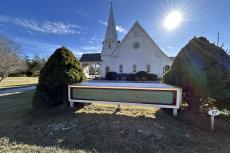The East Hampton Town Board held a public hearing last Thursday on proposed amendments to the town code that are intended to tighten control over the massive geotextile sandbags that are used to protect waterfront properties from erosion.
While they are at present permitted on an emergency basis for up to six months with the potential for a three-month extension, that provision is often ignored, with several instances in which the sandbags, each weighing some 1,700 pounds and tied and stacked together, have remained in place for as long as a decade.
Brian Frank, the Planning Department's chief environmental analyst, told the board in May that sets of geotextile sandbags function as seawalls do, including in their detrimental impact on beaches: They cause erosion at either end, impacting adjoining properties, exacerbate erosion at the property they are intended to protect, limit or prevent public access, and lower the beach itself.
"The provision of the code was to allow for their temporary use on a short-term and definitive basis, really, to prevent imminent damage to a structure imperiled by erosion," Mr. Frank said last Thursday before summarizing the proposed code revisions.
They would empower the building inspector to consult with different town departments to determine if the structure to be protected is in imminent peril, where the code now limits consultation to the town engineer and the fire marshal; allow the building inspector to consult with an engineer other than the designer of the geotextile structure; limit the length of the sandbags to that necessary to protect a house or principal structure, rather than the entire width of the property; require the posting of a security equal to no less than twice the construction cost to effectuate sandbags' removal, and require an access easement to permit entry onto the property to remove sandbags if they remain beyond the permitted duration.
Public comment ranged from the proposed revisions being too onerous to not going far enough. The revised code would be "unnecessarily restrictive," said Nick Grecco of Amagansett. Joe Karpinski, also of Amagansett, represented the latter view, complaining about the wall of geotextile sandbags at the end of Bay View Avenue in that hamlet, a private road that nonetheless offered public beach access until a group of sandbags blocked it. There is a dangerous, seven-foot drop from the top of the sandbags to the beach, he said.
Rameshwar Das, chairman of the town's waterfront advisory committee, spoke forcefully in favor of the proposed revisions. The primary concern, he said, "has been over a mechanism to ensure the removal of these structures in a timely fashion, and the requirement of the bond, I think, is probably the principal advance in the code, and really a necessary one," because "if there are no teeth to enforcing a provision like this in the code, they will not be enforced."
Geotextile sandbags have proven to act as hard structures, Mr. Das said. "I have walked that beach for many years along Cranberry Hole Road" in Amagansett, "and other areas that would be affected by this," he said, and geotextile sandbags' deleterious effect is clear. "I believe that the emergency provisions have been so misused," he said, "that it really is time, and overtime, for corrective action to be taken." He encouraged the board to vote to amend the code "in hopes that they will preserve our shoreline and public resources of our beaches in ways that have not been occurring."
The hearing was closed, and the board is expected to vote on the proposed revisions at a future meeting.




